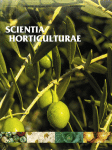Ver ítem
- xmlui.general.dspace_homeCentros Regionales y EEAsCentro Regional Buenos Aires NorteEEA San PedroArtículos científicosxmlui.ArtifactBrowser.ItemViewer.trail
- Inicio
- Centros Regionales y EEAs
- Centro Regional Buenos Aires Norte
- EEA San Pedro
- Artículos científicos
- Ver ítem
Identification of peach accessions stability and adaptability in non-balanced trials through years
Resumen
Identification of genotypes with acceptable yield and yield stability in different environments is an important issue in plant breeding. Genotype-by-environment interaction (GEI) can alter genotypes performances making the selection of superior material a tedious task for breeders. Consequently, it is necessary to assess the usefulness of different available methods and identify the most suitable for understanding GEI. The objectives of this work were to
[ver mas...]
Identification of genotypes with acceptable yield and yield stability in different environments is an important issue in plant breeding. Genotype-by-environment interaction (GEI) can alter genotypes performances making the selection of superior material a tedious task for breeders. Consequently, it is necessary to assess the usefulness of different available methods and identify the most suitable for understanding GEI. The objectives of this work were to compare three methods to study genotype stability considering incomplete data sets: (i) Di Rienzo, Guzmán and Casanoves’ test (DGC), (ii) relative yield (RY) and (iii) Piepho’s method. In addition, AMMI (additive main effect and multiplicative interaction) analysis and eight AMMI stability measures SIPC, EV, ASV, Da, FP, B, FA and Za were computed to explore their advantages and disadvantages to select stable entries. The usefulness of the genotype selection index (GSI) and the rank-sum (RS) procedures to identify stable and high-yielding genotypes were evaluated and then compared with the superiority (P) and reliability indexes (I).The association between yield variation and climatic factors as frosts, chilling, heat, rainfall and the interactions among them were also analyzed. 29 peach entries were assessed in four to seven seasons in a completely randomized design with three replications. DGC and RY tests agreed on classifying Fireprince as a stable and high-yielding peach, RY classified 25 entries as stable, while Piepho’s method did not separate the tested genotypes as DGC and RY did. The results of AMMI indicated that 25.06% of total variability was justified by genotypes, 9.76% by environments and 58.97% by GEI. The first five interaction principal components could explain 94.82% of GEI and showed the efficiency of AMMI model to study and understand GEI. The AMMI parameters showed no association with fruit yield, therefore, they could be useful to indicate stable entries but they would not be appropriate to select stable and high-yielding genotypes. The EV and Za indicated static stability while ASV, SIPC, Da, FA and FP pointed out the dynamic stability concept. The performance of the best entries selected by GSI, RS, P and I procedures were not different, therefore, any of them can be used to select superior peach genotypes. Rainfall during endodormancy, rainfall from floral bud endo- to ecodormancy - and heat accumulation during fruit development period showed significant correlation with yield variation across seasons.
[Cerrar]

Autor
Maulion, Evangelina;
Arroyo, Luis Enrique;
Daorden, Maria Elena;
Valentini, Gabriel Hugo;
Cervigni, Gerardo Domingo Lucio;
Fuente
Scientia horticulturae 199 : 198-208. (February 2016)
Fecha
2016
ISSN
0304-4238
Formato
pdf
Tipo de documento
article
Palabras Claves
Derechos de acceso
Restringido
 Excepto donde se diga explicitamente, este item se publica bajo la siguiente descripción: Creative Commons Attribution-NonCommercial-ShareAlike 2.5 Unported (CC BY-NC-SA 2.5)
Excepto donde se diga explicitamente, este item se publica bajo la siguiente descripción: Creative Commons Attribution-NonCommercial-ShareAlike 2.5 Unported (CC BY-NC-SA 2.5)

